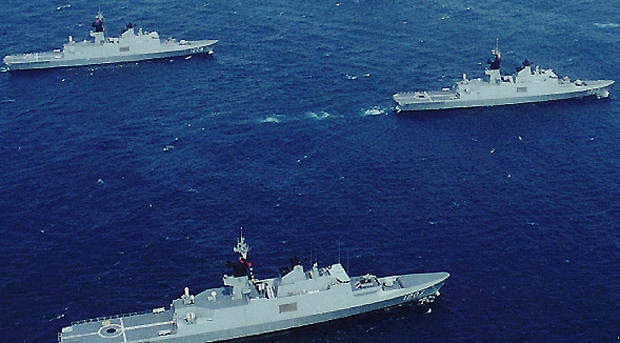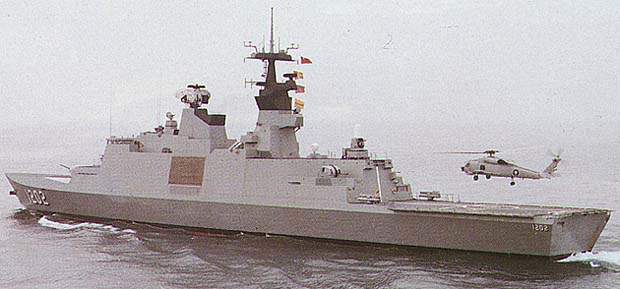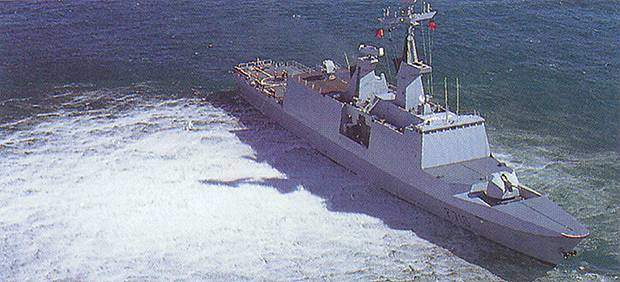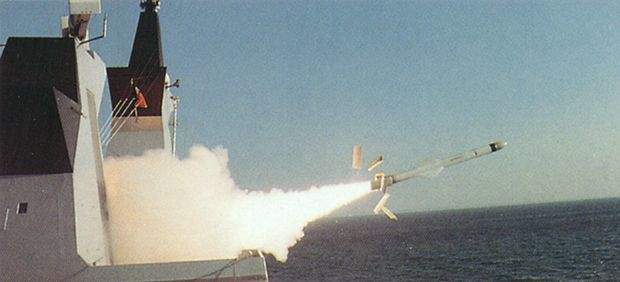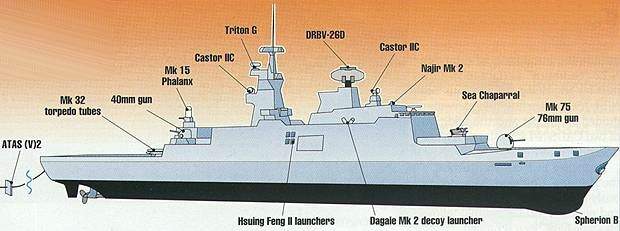The Kang Ding Class are La Fayette Class frigates built for the Taiwanese Navy. In 1992, the Taiwanese government contracted with prime contractor Thales (formerly Thomson CSF), arranging for the construction of six ships. Weapons assembly was to take place in Taiwan, carried out by the China SB Corporation at Kaohsiung.
The frigates were constructed at French state shipbuilder DCN’s Lorient Naval Dockyard. The first ship, the Kang Ding, arrived at Taiwan’s Tsoyng naval base in May 1996; the final frigate of the six, Chan Te, was launched in August 1996, and was commissioned for service with the Republic of China Navy in January 1998.
Hulls include: Kang Ding (1202), which was commissioned in June 1996, Si Ning (1203), in September 1996, Wu Chang (1205), in December 1997, Di Hua (1206), in August 1997, Kun Ming (1207), in August 1998 and Chen Te (1209), in January 1998.
KANG DING DESIGN
The Kang Ding Class frigates are modelled on the French La Fayette Class design, but differ in both structure and weapons systems. Its anti-submarine capability has been considerably enhanced and additional guns have also been fitted. The ship is designed to carry one Sikorsky S-70C(M)1 ASW helicopter.
The ship displaces 3,500t fully loaded, and has dimensions of 125m x 15.4m x 4m. With a maximum speed of 25kt, it has a range of 7,000nm at 15kt. The ship can accommodate a complement of 134, including 15 officers.
COMMAND AND CONTROL
The combat data system is a Thales Tacticos system; weapons control for the main gun is by EADS Systems & Defence Electronics Najir Mk 2 optronic director.
WEAPONS
The ship is armed with two four-cell launchers for the Taiwanese-designed Hsiung Feng II surface-to-surface missile. Hsiung Feng II has inertial guidance with active radar and infrared homing to a range of 130km. There is one four-cell launcher for the Lockheed Martin Sea Chaparral surface-to-air missile, which has an infrared seeker and range of 9km.
The main gun is an Oto Melara 76mm / 62 mk 75 gun, which fires 6kg shells at a rate of 85 rounds a minute to a range of 15km. Two Bofors 40mm/70 guns are also fitted. The Raytheon / General Dynamics 20mm / 76 Phalanx mk 15 mod 2 Close-In Weapon System (CIWS) fires at a rate of 3,000 rounds a minute to a range of 1.5km. Raytheon has been awarded a contract to provide the Phalanx Block 1A upgrade. The Block 1A configuration adds increased ammunition, a high-order-language computer and expanded radar search and track envelopes to counter modern anti-ship missile threats.
Six 324mm mk 32 (2 triple) torpedo tubes are fitted for ATK (Alliant Techsystems) mk 36 mod 5 torpedoes.
COUNTERMEASURES
Countermeasures include two Sagem Défense Sécurité (formerly EADS Defence & Electronics) Dagaie chaff launchers, and a Thales DR3000S radar warning receiver, operating in bands D to K.
SENSORS
Surface search is provided by Thales Triton G radar, operating at G-band. The air / surface search radar is Thales DRBV-26D radar, operating at D-band, and fire control radar is by two Thales Castor IIC I/J-Band radars. Two Thales defence (formerly Racal) 20V90 radars provide navigation and air control for the helicopter.
Sonars include the Thales Underwater Systems (formerly Thomson Marconi Sonar) ATAS (V)2 active towed array; and the Thales Spherion B bow-mounted active search, medium-frequency sonar.
PROPULSION
The ship is driven by a CODAD (Combined Diesel and Diesel) system, made up of four SEMT-Pielstick 12 PA6 V 280 STC (Sequential Turbo Charging) diesels each rated at 5200hp at 1050rpm, with two shafts.

